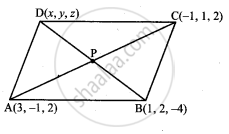Advertisements
Advertisements
प्रश्न
Three vertices of a parallelogram ABCD are A (3, –1, 2), B (1, 2, –4) and C (–1, 1, 2). Find the coordinates of the fourth vertex.
उत्तर
Vertices A and C are (3, –1, 2), (−1, 1, 2) respectively.

Coordinates of the midpoint P between A and C `((3 - 1)/2, (-1 + 1)/2, (2 + 2)/2)` = (1, 0, 2)
Let the coordinates of point D be (x, y, z) and the coordinates of point B be (1, 2, −4).
∴ Mid point of DB `(("x" + 1)/2, ("y" + 2)/2, ("z" - 4)/2)`
The diagonals of a parallelogram divide each other into 2 equal parts.
Therefore, `("x" + 1)/2 = 1, ("y" + 2)/2 = 0, ("z" - 4)/2 = 2`
Hence, the coordinates of point D are (1, –2, 8).
APPEARS IN
संबंधित प्रश्न
Coordinate planes divide the space into ______ octants.
Name the octants in which the following points lie: (5, 2, 3)
Name the octants in which the following points lie:
(4, –3, 5)
Name the octants in which the following points lie:
(–5, –4, 7)
Name the octants in which the following points lie:
(2, –5, –7)
Planes are drawn through the points (5, 0, 2) and (3, –2, 5) parallel to the coordinate planes. Find the lengths of the edges of the rectangular parallelepiped so formed.
Find the distances of the point P(–4, 3, 5) from the coordinate axes.
Determine the point on z-axis which is equidistant from the points (1, 5, 7) and (5, 1, –4).
Find the points on z-axis which are at a distance \[\sqrt{21}\]from the point (1, 2, 3).
Show that the points A(3, 3, 3), B(0, 6, 3), C(1, 7, 7) and D(4, 4, 7) are the vertices of a square.
Find the locus of P if PA2 + PB2 = 2k2, where A and B are the points (3, 4, 5) and (–1, 3, –7).
Show that the points (a, b, c), (b, c, a) and (c, a, b) are the vertices of an equilateral triangle.
Are the points A(3, 6, 9), B(10, 20, 30) and C(25, –41, 5), the vertices of a right-angled triangle?
Verify the following:
(0, 7, –10), (1, 6, –6) and (4, 9, –6) are vertices of an isosceles triangle.
Find the locus of the point, the sum of whose distances from the points A(4, 0, 0) and B(–4, 0, 0) is equal to 10.
Find the ratio in which the sphere x2 + y2 + z2 = 504 divides the line joining the points (12, –4, 8) and (27, –9, 18).
Show that the plane ax + by + cz + d = 0 divides the line joining the points (x1, y1, z1) and (x2, y2, z2) in the ratio \[- \frac{a x_1 + b y_1 + c z_1 + d}{a x_2 + b y_2 + c z_2 + d}\]
Write the length of the perpendicular drawn from the point P(3, 5, 12) on x-axis.
Find the ratio in which the line segment joining the points (2, 4,5) and (3, −5, 4) is divided by the yz-plane.
Find the point on x-axis which is equidistant from the points A (3, 2, 2) and B (5, 5, 4).
The ratio in which the line joining (2, 4, 5) and (3, 5, –9) is divided by the yz-plane is
XOZ-plane divides the join of (2, 3, 1) and (6, 7, 1) in the ratio
The length of the perpendicular drawn from the point P (3, 4, 5) on y-axis is
The coordinates of the foot of the perpendicular drawn from the point (2, 5, 7) on the x-axis are given by ______.
If the line drawn from the point (–2, – 1, – 3) meets a plane at right angle at the point (1, – 3, 3), find the equation of the plane
Find the equations of the two lines through the origin which intersect the line `(x - 3)/2 = (y - 3)/1 = z/1` at angles of `pi/3` each.
Two systems of rectangular axis have the same origin. If a plane cuts them at distances a, b, c and a′, b′, c′, respectively, from the origin, prove that
`1/a^2 + 1/b^2 + 1/c^2 = 1/(a"'"^2) + 1/(b"'"^2) + 1/(c"'"^2)`
Find the foot of perpendicular from the point (2,3,–8) to the line `(4 - x)/2 = y/6 = (1 - z)/3`. Also, find the perpendicular distance from the given point to the line.
Show that the points `(hati - hatj + 3hatk)` and `3(hati + hatj + hatk)` are equidistant from the plane `vecr * (5hati + 2hatj - 7hatk) + 9` = 0 and lies on opposite side of it.
Show that the straight lines whose direction cosines are given by 2l + 2m – n = 0 and mn + nl + lm = 0 are at right angles.
If the directions cosines of a line are k, k, k, then ______.
The plane 2x – 3y + 6z – 11 = 0 makes an angle sin–1(α) with x-axis. The value of α is equal to ______.
The vector equation of the line `(x - 5)/3 = (y + 4)/7 = (z - 6)/2` is ______.
The cartesian equation of the plane `vecr * (hati + hatj - hatk)` is ______.
The unit vector normal to the plane x + 2y +3z – 6 = 0 is `1/sqrt(14)hati + 2/sqrt(14)hatj + 3/sqrt(14)hatk`.
